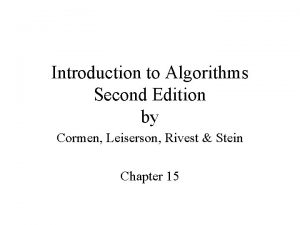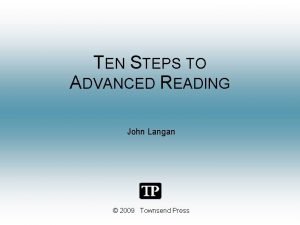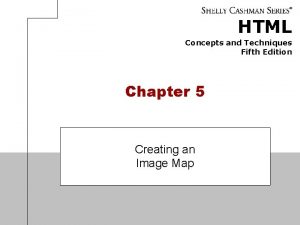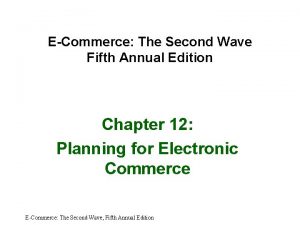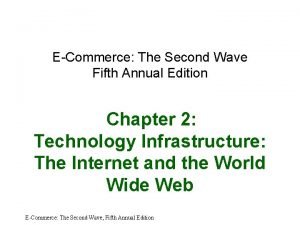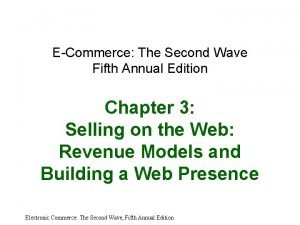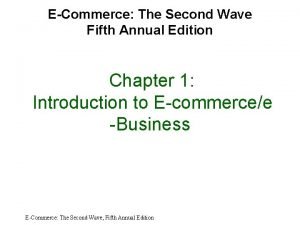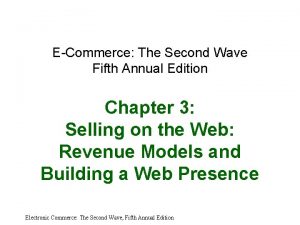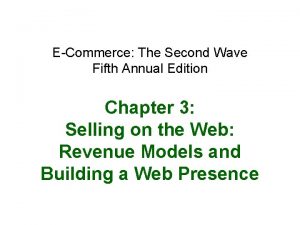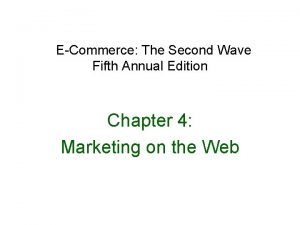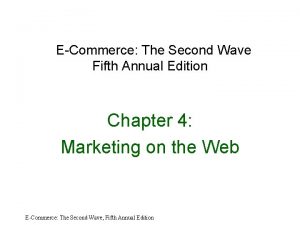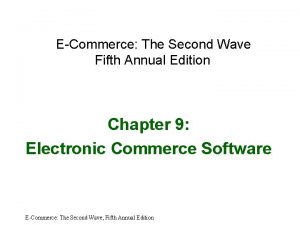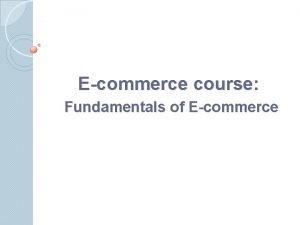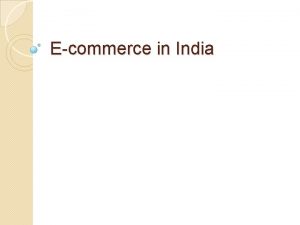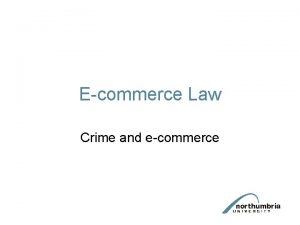ECommerce The Second Wave Fifth Annual Edition Chapter












































- Slides: 44

E-Commerce: The Second Wave Fifth Annual Edition Chapter 8: Web Server Hardware and Software E-Commerce: The Second Wave, Fifth Annual Edition

Objectives In this chapter, you will learn about: • Web server basics • Software for Web servers • Internet utility programs • Web server hardware E-Commerce: The Second Wave, Fifth Annual Edition 2

Web Server Basics • Main job of a Web server computer – To respond to requests from Web client computers • Three main elements of a Web server – Hardware – Operating system software – Web server software E-Commerce: The Second Wave, Fifth Annual Edition 3

Types of Web Sites • Development sites – Used to evaluate different Web designs • Intranets – Corporate networks that house internal memos, corporate policy handbooks • Extranets – Intranets that allow authorized parties outside the company to access information stored in the system E-Commerce: The Second Wave, Fifth Annual Edition 4

Types of Web Sites (Continued) • Transaction-processing sites – Commerce sites that must be available 24 hours a day, seven days a week • Content-delivery sites – Deliver content such as news, histories, summaries, and other digital information E-Commerce: The Second Wave, Fifth Annual Edition 5

Web Clients and Web Servers • Client/server architectures – Client computers typically request services – Server processes clients’ requests • Web software – Lets different types of computers, running different operating systems, communicate E-Commerce: The Second Wave, Fifth Annual Edition 6

Platform Neutrality of the Web E-Commerce: The Second Wave, Fifth Annual Edition 7

Dynamic Content • Nonstatic information constructed in response to a Web client’s request • Dynamic page – Web page whose content is shaped by a program in response to user requests • Static page – An unchanging page retrieved from disk E-Commerce: The Second Wave, Fifth Annual Edition 8

Dynamic Content (Continued) • Server-side scripting – Programs running on Web server create Web pages before sending them back to the requesting Web clients • Dynamic page-generation technologies – Active Server Pages (ASP) – Java. Server Pages (JSP) – PHP: Hypertext Preprocessor (PHP) E-Commerce: The Second Wave, Fifth Annual Edition 9

Various Meanings of “Server” • Server – Computer used to provide files or make programs available to other computers • Server software – Used by server computer to make files and programs available to other computers • Database server – Server computer on which database management software runs E-Commerce: The Second Wave, Fifth Annual Edition 10

Two-Tier Client/Server Architecture • Has only one client and one server • Request message – Message that a Web client sends to request a file or files from a Web server • Typical request message – Request line – Optional request headers – Optional entity body E-Commerce: The Second Wave, Fifth Annual Edition 11

Message Flows in a Two-tier Client/Server Network E-Commerce: The Second Wave, Fifth Annual Edition 12

Two-Tier Client/Server Architecture (Continued) • Request line – Contains command, name of target resource, and protocol name and version number • Request headers – Can contain information about types of files that client will accept in response to request • Entity body – Used to pass bulk information to the server E-Commerce: The Second Wave, Fifth Annual Edition 13

Two-Tier Client/Server Architecture (Continued) • Three-tier architecture – Extends two-tier architecture to allow additional processing • N-tier architectures – Higher-order architectures – Third tier includes software applications that supply information to Web server E-Commerce: The Second Wave, Fifth Annual Edition 14

Message Flows in a Three-tier Client/Server Network E-Commerce: The Second Wave, Fifth Annual Edition 15

Software for Web Servers • Operating system tasks – Running programs and allocating computer resources • Linux – Open-source operating system that is easy to install, fast, and efficient • Open-source software – Developed by community of programmers who make it available for download at no cost E-Commerce: The Second Wave, Fifth Annual Edition 16

Web Server Software • Most popular Web server programs – Apache HTTP Server – Microsoft Internet Information Server (IIS) – Sun Java System Web Server (JSWS) • Netcraft – A networking consulting company in Bath, England – Accumulated popularity rankings E-Commerce: The Second Wave, Fifth Annual Edition 17

Market Shares for Top Web Server Software E-Commerce: The Second Wave, Fifth Annual Edition 18

Apache HTTP Server • Ongoing group software development effort • Dominated Web since 1996 because it is free and performs efficiently • Apache – Developed by Rob Mc. Cool at University of Illinois in 1994 at the NCSA – Currently available on the Web at no cost as open-source software E-Commerce: The Second Wave, Fifth Annual Edition 19

Microsoft Internet Information Server • Comes bundled with current versions of Microsoft Windows Server operating systems • Used on many corporate intranets • Supports the use of – ASP – Active. X Data Objects – SQL database queries E-Commerce: The Second Wave, Fifth Annual Edition 20

Sun Java System Web Server (Sun ONE, i. Planet, Netscape) • Descendant of original NCSA Web server program • Formerly sold under the names – Sun ONE – Netscape Enterprise Serve – i. Planet Enterprise Server • Charges a $1500 -per-CPU licensing fee E-Commerce: The Second Wave, Fifth Annual Edition 21

Web Site and Internet Utility Programs • Finger – Runs on UNIX operating systems – Allows users to obtain information about other network users – Command yields list of users who are logged on to network • Ping (Packet Internet Groper) – Tests connectivity between two computers connected to the Internet E-Commerce: The Second Wave, Fifth Annual Edition 22

Tracert and Other Route-Tracing Programs • Tracert (TRACE Rou. Te) – Sends data packets to every computer on the path between one computer and another – Clocks packets’ roundtrip times – Calculate and display number of hops between computers – Calculate time it takes to traverse entire oneway path between machines E-Commerce: The Second Wave, Fifth Annual Edition 23

Tracing a Path Between Two Computers on the Internet E-Commerce: The Second Wave, Fifth Annual Edition 24

Electronic Mail • Useful feature – Attachments • Drawbacks – Time spent by business people responding to e-mail – Computer virus • Program that attaches itself to another program • Can cause damage when host program is activated E-Commerce: The Second Wave, Fifth Annual Edition 25

Unsolicited Commercial E-Mail (UCE, Spam) • Electronic junk mail that can include – Solicitations, advertisements, or e-mail chain letters • Can consume large amounts of Internet capacity • Companies – Now offer software to limit amount of spam E-Commerce: The Second Wave, Fifth Annual Edition 26

Growth of Spam as a Proportion of all Business E-mail E-Commerce: The Second Wave, Fifth Annual Edition 27

Solutions to the Spam Problem • Reduce likelihood that a spammer can automatically generate e-mail addresses • Control exposure of an e-mail address • Use multiple e-mail addresses • Content filtering strategy – Require software that identifies content elements that indicate if message is (or is not) spam E-Commerce: The Second Wave, Fifth Annual Edition 28

Solutions to the Spam Problem (Continued) • Content-filtering techniques – Black list spam filter • Looks for known spammer From addresses in incoming messages – White list spam filter • Examines From addresses and compares them to list of known good sender addresses – Challenge-response • Compares all incoming messages to a white list E-Commerce: The Second Wave, Fifth Annual Edition 29

Telnet and FTP Utilities • Telnet – Program that allows users to log on to a computer connected to the Internet • Telnet protocol – Set of rules used by Telnet programs • File Transfer Protocol (FTP) – Defines formats used to transfer files between TCP/IP-connected computers E-Commerce: The Second Wave, Fifth Annual Edition 30

Indexing and Searching Utility Programs • Search engines or search tools – Search either a specific site or the entire Web for requested documents • Indexing program – Can provide full-text indexing that generates an index for all documents stored on server – Can often index documents stored in many different file formats E-Commerce: The Second Wave, Fifth Annual Edition 31

Data Analysis Software • Web servers can capture – Data about who is visiting a Web site – How long the visitor’s Web browser viewed site – Date and time of each visit – Which pages visitor viewed • Data captured by Web servers – Stored in a log file E-Commerce: The Second Wave, Fifth Annual Edition 32

Web. Trends Log File Analysis E-Commerce: The Second Wave, Fifth Annual Edition 33

Link-Checking Utilities • Link checker – Examines each Web page and reports on URLs that are • Broken, seem broken, or are in some way incorrect • Orphan file – File on Web site not linked to any Page • Dead link – When clicked, displays error message rather than a Web page E-Commerce: The Second Wave, Fifth Annual Edition 34

Watchfire Link Report E-Commerce: The Second Wave, Fifth Annual Edition 35

Remote Server Administration • Web site administrator can control Web site from any Internet-connected computer • Net. Mechanic – Offers variety of link-checking, HTML troubleshooting, site-monitoring, and other programs E-Commerce: The Second Wave, Fifth Annual Edition 36

Web Server Hardware • Web server computers – More memory, larger hard disk drives, and faster processors • Blade servers – Placing small server computers on a single computer board, then installing boards into a rack -mounted frame • Virtual server (virtual host) – Maintains more than one server on one machine E-Commerce: The Second Wave, Fifth Annual Edition 37

Web Server Performance Evaluation • Benchmarking – Testing used to compare the performance of hardware and software • Throughput – Number of HTTP requests that hardware and software combination can process in a unit of time • Response time – Time required by server to process one request E-Commerce: The Second Wave, Fifth Annual Edition 38

Web Server Hardware Architectures • Server farms – Large collections of servers • Centralized architecture – Uses a few very large and fast computers • Distributed/decentralized architecture – Uses large number of less powerful computers – Divides the workload among them E-Commerce: The Second Wave, Fifth Annual Edition 39

Load-Balancing Systems • Load-balancing switch – Piece of network hardware that monitors the workloads of servers attached to it – Assigns incoming Web traffic to server that has the most available capacity at that instant in time E-Commerce: The Second Wave, Fifth Annual Edition 40

A Load-Balancing System in a Decentralized Architecture E-Commerce: The Second Wave, Fifth Annual Edition 41

Complex Load Balancing E-Commerce: The Second Wave, Fifth Annual Edition 42

Summary • Web uses – Client/server architecture • For simple HTTP requests – Two-tier architecture works well • Operating systems commonly used on Web server computers – Microsoft server operating systems – UNIX-based operating systems E-Commerce: The Second Wave, Fifth Annual Edition 43

Summary • Utility programs running on Web server computers – Finger, Ping, Tracert, email server software, Telnet, and FTP • Web server hardware – Server computer must have enough memory and disk space • Factors that affect Web server performance – Operating system – Connection speed – User capacity E-Commerce: The Second Wave, Fifth Annual Edition 44
 One two three four five six to hundred
One two three four five six to hundred Nic in nursing
Nic in nursing Principles of marketing fifth european edition
Principles of marketing fifth european edition Lazarus appraisal theory
Lazarus appraisal theory Fundamentals of corporate finance fifth edition
Fundamentals of corporate finance fifth edition Democritus atomic model diagram
Democritus atomic model diagram Mitosis
Mitosis Molecular biology of the cell fifth edition
Molecular biology of the cell fifth edition Human anatomy fifth edition
Human anatomy fifth edition Human anatomy fifth edition
Human anatomy fifth edition 27 miles per gallon into kilometers per liter
27 miles per gallon into kilometers per liter Advanced word power second edition answers
Advanced word power second edition answers Accounting principles second canadian edition
Accounting principles second canadian edition Accounting principles second canadian edition
Accounting principles second canadian edition Accounting principles second canadian edition
Accounting principles second canadian edition Clear thinking and writing second edition answer key
Clear thinking and writing second edition answer key Accounting principles second canadian edition
Accounting principles second canadian edition Kaufman test of educational achievement
Kaufman test of educational achievement Introduction to algorithms 2nd edition
Introduction to algorithms 2nd edition In company second edition
In company second edition Wechsler individual achievement test second edition
Wechsler individual achievement test second edition Ten steps to advanced reading 2nd edition answers
Ten steps to advanced reading 2nd edition answers Organic chemistry second edition david klein
Organic chemistry second edition david klein Using mis 10th edition
Using mis 10th edition Chapter 1
Chapter 1 Second wave colonialism
Second wave colonialism Second wave civilizations
Second wave civilizations Second wave of positive psychology
Second wave of positive psychology The harder you push the harder the system pushes back
The harder you push the harder the system pushes back Fifth chapter menu
Fifth chapter menu Light waves are electromagnetic waves true or false
Light waves are electromagnetic waves true or false What is a semiconductor used for
What is a semiconductor used for Difference between full wave and half wave rectifier
Difference between full wave and half wave rectifier Longitudinal vs transverse waves
Longitudinal vs transverse waves Half wave rectifier meaning
Half wave rectifier meaning Bridge type rectifier circuit
Bridge type rectifier circuit Earthquake p-wave and s-wave travel time graph
Earthquake p-wave and s-wave travel time graph Rectified sine wave fourier series
Rectified sine wave fourier series Longitudinal wave
Longitudinal wave The nature of waves chapter 10 section 1
The nature of waves chapter 10 section 1 Non periodic function fourier series
Non periodic function fourier series Electromagnetic and mechanical waves
Electromagnetic and mechanical waves A matter in which waves can travel and transfer energy
A matter in which waves can travel and transfer energy Wavelength formula triangle
Wavelength formula triangle Hát kết hợp bộ gõ cơ thể
Hát kết hợp bộ gõ cơ thể


















